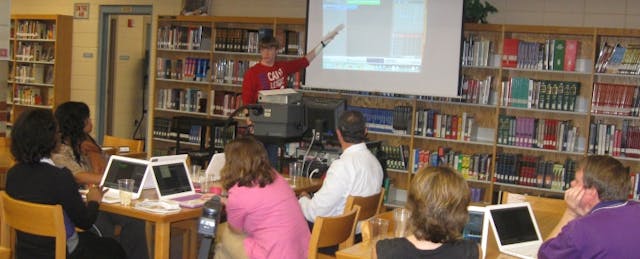Over the course of my time as a student, I have been lucky enough to see technology evolve from dial-up Internet and floppy disks, to high speed wireless and pocket-sized mobile computers. Now, as a high school student, I couldn’t imagine not being able to access any resource I want from my smartphone. Educational technology is changing faster than ever, and I am so excited to see its continued growth. However, I realize that if my teachers don’t have the right knowledge about educational technology programs those programs can be misused or not be used at all.
So, I spend my time helping teachers. In my freshman year of high school, I developed a program for staff members that was designed to support and encourage the use of technology in their classroom. I taught teachers how to use their computers - I even assigned quizzes to check for understanding!
As a student who supports staff members with technology, I see that it is challenging at times. I want my teachers to use educational technology more effectively, but at the same time I see and understand the struggles they are going through. Many teachers are having difficulty trying to implement edtech when there are new initiatives to focus on such as the Common Core and new teacher evaluations. They feel they don’t have the time to invest in new technology skills.
However, the teachers who are eager to learn have asked me for some advice over the years about implementing edtech, and this is what I tell them:
1. Keep it simple
Edtech programs are supposed to make life better in the school system. They are supposed to help teachers in some way, and they are supposed to enhance students’ technology skills. Always keep in mind technology is supposed to enhance your life, somehow someway. If it isn’t - it’s not working.
When teachers want to implement technology, they over compensate for lost time. Teachers tend to do too much in the beginning, and then it feels overwhelming for the teacher and the students.
So, keep it simple. The program you implement shouldn’t be too complicated. It should be easy enough to explain in a sentence or two. For instance, a teacher using Google Apps for Education should tell their students that they will be using it to complete and submit various writing assignments. If a teacher is going to implement a program like Socrative, they tell their students it is a program to collect instant feedback. Be cautious though - there is such a thing as too much too fast in the educational technology world!
2. Have a few tools in your basket
There are thousands upon thousands upon thousands of edtech programs - and more are added every single day (so it seems). From Edmodo to Google Drive, to Socrative to PollEverywhere - there is a lot out there. Find a couple of programs you enjoy and get to know them really well.
There is no such thing as a “one size fits all” technology. For example, in one class, Edmodo may be a great way to communicate to the class - but in another class, it may not work at all. No one should know every single edtech program ever created, but keeping a few programs in your basket won’t hurt.
3. Engage vs. entertain
For some reason, my teachers believe that the 21st century learner needs to be entertained. I am here to tell you as a student, that is not accurate at all. Students want to and need to be engaged with their learning - not entertained.
A lot of edtech tools do a good job engaging students - but be careful, there are some programs that just want to entertain rather than engage. When students are entertained, they tend to just watch a video, and then answer a few questions after the video. How engaging is that? Something like Blackboard requires everyone to be engaged in their learning, since Blackboard allows for online collaboration and discussion.
4. Plan for the worst
As we all know, sometimes technology does not work the way we want it to. The worst scenario is when these tools depend on the Internet - and the Internet is down, or even worse the power is out! Teachers should always have a “plan B” for when these edtech programs may fail. In the off chance that technology does not work, a lesson can always be amended, and then later enhanced with technology. For a movie project, students can work on the script and storyboard without technology, and then create the film when technology is functioning properly.
5. Have fun!
If you aren’t having fun, you’re using the wrong one. These tools are supposed to eliminate stress - or at least reduce the amount of stress. If you aren’t enjoying edtech, your students probably aren’t either.
I hope that technology in schools will take off like a rocket ship in this country. If there is ever a teacher doubting edtech programs, I encourage them to just try one. There are so many tools, and I guarantee you will find one you love. With the consistent use and support from their teachers incorporating new technology, students will enhance their tech skills and be more prepare for this fast-paced, developing, world that lies ahead.


